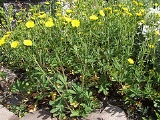
Potentilla recta
Encyclopedia
Potentilla recta is a species of cinquefoil
. It is native to Eurasia but it is present in North America
as an introduced species
, ranging through almost the entire continent except the northernmost part of Canada
and Alaska
.
The plant probably originated in the Mediterranean Basin
, and it was first collected in the 19th century in Ontario
and in 1914 in British Columbia
. It is known as a minor noxious weed in some areas. It occurs in many types of habitat, including disturbed, weedy places.
This perennial herb is a tufted plant growing from a woody taproot
or caudex
. It produces upright to erect leafy stems up to 80 centimeters tall. The leaves are palmate, divided into usually 6 or 7 leaflets, sometimes up to nine. The green to yellow-green leaves may be up to 15 centimeters long, with the central leaflet reaching 8 centimeters in length. The leaflets are hairy in texture and toothed along the edges. The inflorescence
is a cyme of several flowers which are generally light to pale yellow in color, with white to gold-flowered individuals occurring at times. The plant may reproduce by seed or vegetatively
by sprouting new shoots from its caudex.
Potentilla
Potentilla is the genus of typical cinquefoils, containing about 500 species of annual, biennial and perennial herbs in the rose family Rosaceae. They are generally Holarctic in distribution, though some may even be found in montane biomes of the New Guinea Highlands...
. It is native to Eurasia but it is present in North America
North America
North America is a continent wholly within the Northern Hemisphere and almost wholly within the Western Hemisphere. It is also considered a northern subcontinent of the Americas...
as an introduced species
Introduced species
An introduced species — or neozoon, alien, exotic, non-indigenous, or non-native species, or simply an introduction, is a species living outside its indigenous or native distributional range, and has arrived in an ecosystem or plant community by human activity, either deliberate or accidental...
, ranging through almost the entire continent except the northernmost part of Canada
Canada
Canada is a North American country consisting of ten provinces and three territories. Located in the northern part of the continent, it extends from the Atlantic Ocean in the east to the Pacific Ocean in the west, and northward into the Arctic Ocean...
and Alaska
Alaska
Alaska is the largest state in the United States by area. It is situated in the northwest extremity of the North American continent, with Canada to the east, the Arctic Ocean to the north, and the Pacific Ocean to the west and south, with Russia further west across the Bering Strait...
.
The plant probably originated in the Mediterranean Basin
Mediterranean Basin
In biogeography, the Mediterranean Basin refers to the lands around the Mediterranean Sea that have a Mediterranean climate, with mild, rainy winters and hot, dry summers, which supports characteristic Mediterranean forests, woodlands, and scrub vegetation...
, and it was first collected in the 19th century in Ontario
Ontario
Ontario is a province of Canada, located in east-central Canada. It is Canada's most populous province and second largest in total area. It is home to the nation's most populous city, Toronto, and the nation's capital, Ottawa....
and in 1914 in British Columbia
British Columbia
British Columbia is the westernmost of Canada's provinces and is known for its natural beauty, as reflected in its Latin motto, Splendor sine occasu . Its name was chosen by Queen Victoria in 1858...
. It is known as a minor noxious weed in some areas. It occurs in many types of habitat, including disturbed, weedy places.
This perennial herb is a tufted plant growing from a woody taproot
Taproot
A taproot is an enlarged, somewhat straight to tapering plant root that grows vertically downward. It forms a center from which other roots sprout laterally.Plants with taproots are difficult to transplant...
or caudex
Caudex
A caudex is a form of stem morphology appearing as a thickened, short, perennial stem that is either underground or near ground level . It may be swollen for the purpose of water storage, especially in xerophytes...
. It produces upright to erect leafy stems up to 80 centimeters tall. The leaves are palmate, divided into usually 6 or 7 leaflets, sometimes up to nine. The green to yellow-green leaves may be up to 15 centimeters long, with the central leaflet reaching 8 centimeters in length. The leaflets are hairy in texture and toothed along the edges. The inflorescence
Inflorescence
An inflorescence is a group or cluster of flowers arranged on a stem that is composed of a main branch or a complicated arrangement of branches. Strictly, it is the part of the shoot of seed plants where flowers are formed and which is accordingly modified...
is a cyme of several flowers which are generally light to pale yellow in color, with white to gold-flowered individuals occurring at times. The plant may reproduce by seed or vegetatively
Vegetative reproduction
Vegetative reproduction is a form of asexual reproduction in plants. It is a process by which new individuals arise without production of seeds or spores...
by sprouting new shoots from its caudex.

